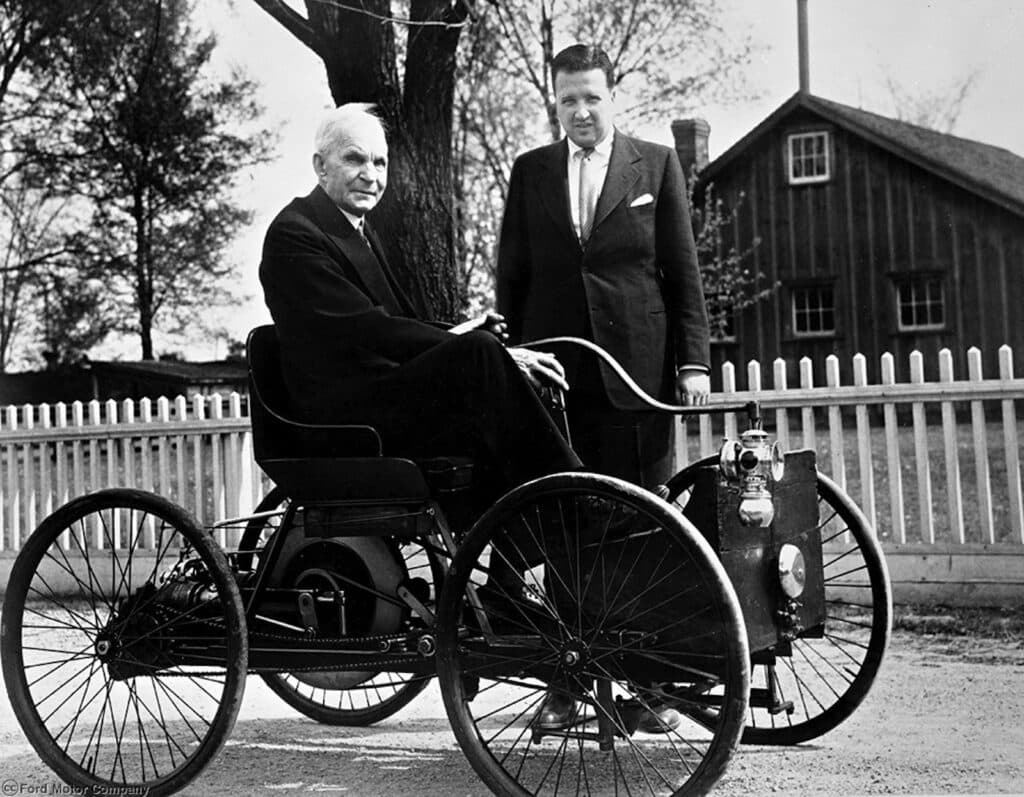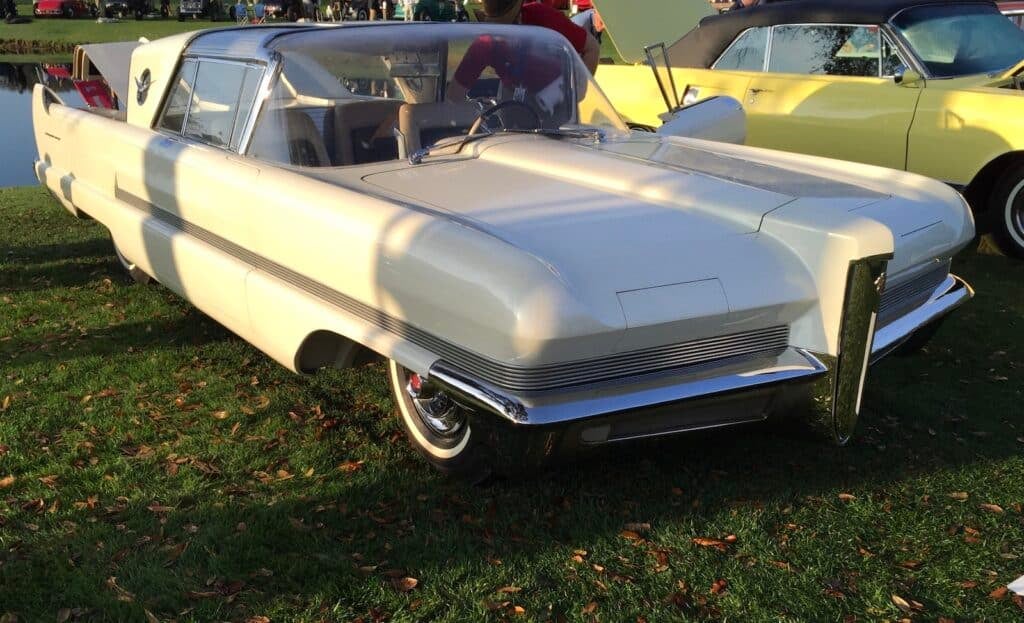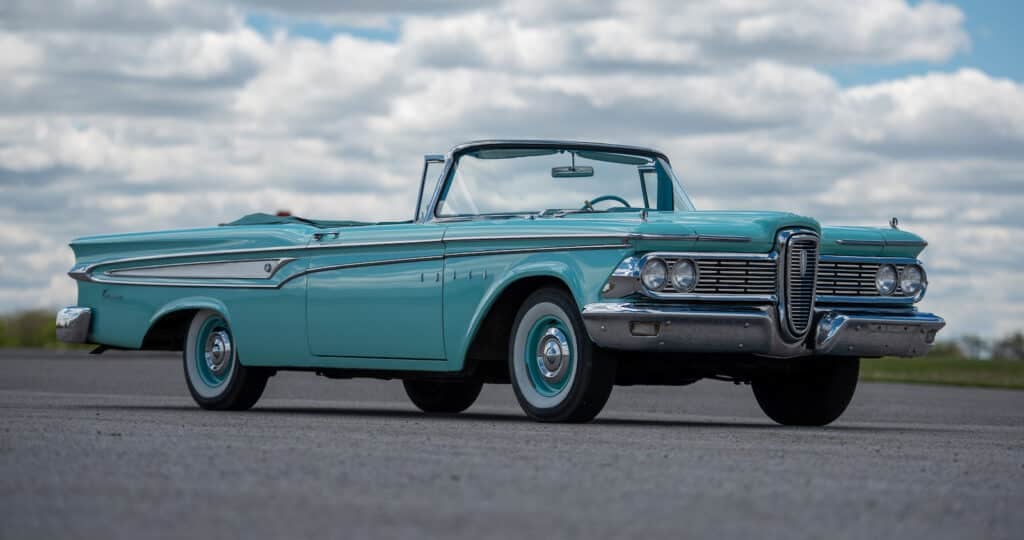
This week in 1959, the Ford Motor Co. announces it is discontinuing production of the Edsel. Named after Henry Ford II’s late father, the company spent 10 years and $250 million on planning it. Offered in 18 models, it arrived just in time for a recession, causing a rising tide of interest in compact cars, not medium-priced ones.
And while the story is well-known by car collectors, its failure came as two different factions battled for control of the automaker.
To get a sense of why it failed, we need to go back to 1948, when the planning for the Edsel, know internally as the E-Car — for Experimental — began taking shape.
Rescuing an icon
Having been released from the Navy to shore up Ford Motor Co., Henry Ford II knew that changed was needed — the company was estimated to be losing $10 million a month. But no one knew how much exactly; the company estimated its accounts payable by weighing invoices on a scale.
Despite lacking experience in such areas, 27-year-old Henry II looked to bring in those who did. He hired The Whiz Kids, 10 MBA-trained Army Air Force Statistical Control officers who joined Ford as a group in 1946, using their expertise in applying statistical techniques to management problems.
With the financial side handled, Henry II turned to manufacturing, tapping a rising General Motors executive, Ernest Breech, to join the company as Executive Vice President. Having earned a reputation as a trouble shooter at GM, Breech went to work, bringing on board a number of talented GM execs who helped lead Ford to a $66 million profit the following year.
The way forward

But Henry II had set up an executive team consisting of bean counters, led by the Whiz Kids, and product men, led by Breech. As the 1950s dawned, Chevrolet, Ford and Plymouth accounted for half of all U.S. sales. GM’s Buick, Oldsmobile and Pontiac nabbed another 25 percent.
The remaining brands split the rest. By 1954, Ford faced a problem. Research revealed that 87% of Chevrolet owners upgraded to a Pontiac, Oldsmobile or Buick; while 77% of Plymouth owners went on to buy a Dodge, DeSoto or Chrysler. Yet only 26% of Ford owners later purchased a Mercury.
By this point, Ford was expanding its product line thanks to Breech’s influence. Ford had introduced the Thunderbird, bringing glamour to a dull brand, and increasing marque sales overall. The company was developing a new Continental, part of an ultra-posh luxury car to take on Cadillac, while Lincoln was repositioned to take on pricier Buick, Oldsmobile and Chrysler models. But there was still a gap in the line-up. Ford had one mid-priced brand, Mercury, while GM had three and Chrysler two. Perceiving a gap, Ford’s new E-Car would be developed to fill it.
All systems go
When it came time to style the car, Roy Brown, who was in charge of styling the car, was asked to lend it a unique identity. With most new cars sporting horizontal grilles, Brown thought of the vertical pre-war Nash, LaSalle and Packards — and penned an updated version. When Breech saw it, he thought it too thin, and asked for it to be enlarged and raised. When the prototype was first revealed to executives they applauded. The car was approved for production.
In the interim, Bill Schmidt, a member of Edsel’s design team, departed Ford and joined Packard. Aware of what Ford was going to do, he developed a comparable stylistic concept, the Packard Predictor, which debuted at the 1956 Chicago Show. Its styling was widely praised, and the new E-Car seemed destined for success.

Over the Breech
Then it came time for a name. Ford had spent a lot of time deciding on a moniker for its new line, summoning poet Marianne Moore for help. She suggested Monogoose Civique, Turcotinga, Bullet Cloisonne, and Andante Con Moto among others. At a board meeting, with no Ford family members present Breech suggested Edsel, Henry Ford’s late son. When they found out, the family was appalled, but somehow, the name stuck.
But things were changing at Ford. Louis Crusoe, a former colleague of Breech’s at GM who championed the first Thunderbird at Ford, was replaced as the head of the division by Robert McNamara, a Whiz Kid whose colleague ran Mercury. This would ultimately hinder the Edsel’s development, as the advanced features first envisioned for the car would be shelved, even as marketers proclaimed the forthcoming car would be truly revolutionary. The problem was, it wasn’t.
When it arrived in 1958, it came offered in Ranger and Pacer trim on Ford’s 118-inch wheelbase and 303 horsepower, or Corsair and Citation trim on Mercury’s 124-inch wheelbase and 345 horsepower. Options included a pushbutton transmission in the steering wheel hub, a drum speedometer and loads of power accessories.
What went wrong

But what the automaker hadn’t counted on was a recession, one that shrank mid-priced model market share to 18% from 25% in 1958. The Edsel’s timing proved ruinous, arriving in time for a recession, causing a rising tide of interest in compact cars, not medium-priced ones. It was just one problem that would doom its chance for success.
Another problem was that consumers found it unappealing, comparing its horizontal grille to a toilet seat. Mockery ensued, which does little for word-of-mouth advertising.
Finally, quality control proved a real problem. The Whiz Kids ascendancy within Ford had led the company to decide that Edsel would not get its own assembly plant. Instead, every 60th job on the assembly line would be an Edsel. As a result, quality suffered with Ford establishing a special operation at their Norfolk, Virginia plant where problem-plagued would be fixed and reassembled before shipment.
Sales proved ok, totaling about 63,000 units in the first year. But Ford had expected to move more than three times that number. The company quickly regrouped, reducing the 1959 to a single 120-inch wheelbase with a choice of a 145-hp inline 6 or a 200-hp V-8. Styling was softened as well, and the grille’s most objectionable feature shrank. Yet the Edsel looked like little more than a reskinned Ford, which did little to help sales, dropping to 45,000 units.
The fallout

As the recession continued, consumers ignored the Edsel, embracing smaller cars such as the Nash Rambler, Studebaker Lark, and any number of imports, principally the Volkswagen Beetle. As the 1960 model year dawned, Ford had a mere 3,000 Edsel orders on hand.
On this week in 1959, Ford Motor Co. killed the Edsel, a car that became renowned for its ugliness. Ironically, Edsel Ford was celebrated for his design prowess and good taste, something the car named for him never had.
Despite Ernest Breech’s interference, Roy Brown took the fall for the design. He was shipped off to England, where he designed the wildly successful 1962 Ford Cortina before returning to America where he designed the 1967 Ford Econoline. Robert McNamara would join the Kennedy administration as Secretary of Defense, while Breech would become Ford’s Chairman of the Board from 1955 through 1960. He remained on the board of directors through 1967. Upon his death in 1978, Henry II described Breech as “a business executive of extraordinary talent and energy who made a major contribution to the postwar revitalization of Ford Motor Company. … I shall miss him.”
It would take Lee Iacocca, and the success of the Ford Mustang, to reignite Ford’s willingness to take chances.
- Coinsmart. Europe’s Best Bitcoin and Crypto Exchange.Click Here
- Platoblockchain. Web3 Metaverse Intelligence. Knowledge Amplified. Access Here.
- Source: https://www.thedetroitbureau.com/2022/11/the-rearview-mirror-the-end-comes-for-edsel/



